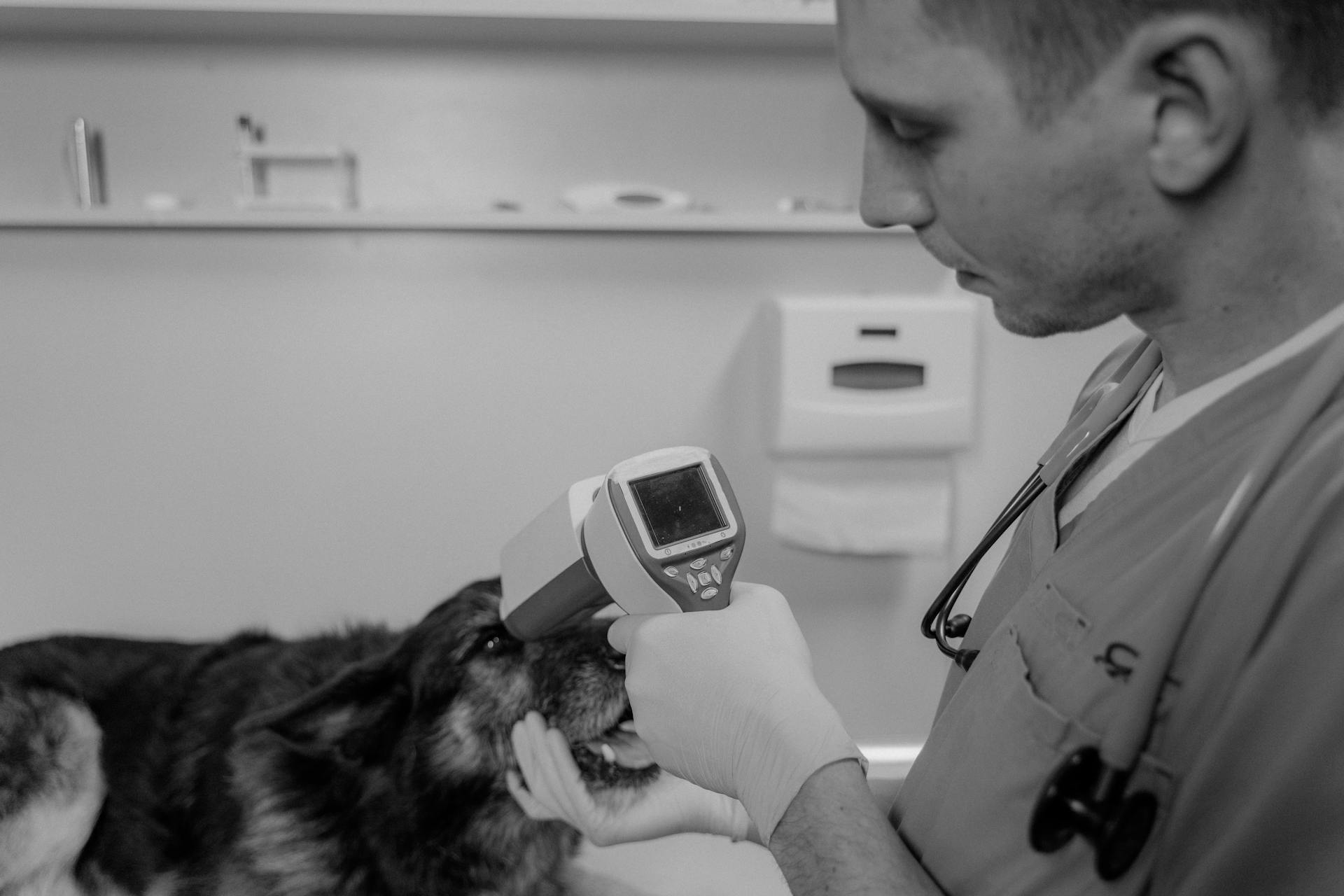
Tracking a dog with a chip for lost pet recovery is a reliable method that has been proven to increase the chances of being reunited with your pet.
A microchip is a small electronic device that is implanted under a dog's skin, and it contains a unique identification number that can be read by a scanner.
This number is then linked to your contact information, which is stored in a database, allowing shelters and vets to quickly identify your dog and contact you.
The American Animal Hospital Association recommends that all dogs be microchipped and registered with a national database.
How Microchips Work
A microchip is essentially a tiny electronic device about the size of a grain of rice that has a unique radio frequency identification (RFID) code.
The chip is injected under the skin, between the shoulder blades, and doesn't require anesthesia or surgeries. This process is similar to getting a routine vaccination.
The microchip uses RFID technology, which provides permanent ID for your pet. It doesn't require a power source like a GPS, and when a scanner is passed over the pet, the microchip gets enough power from the scanner to transmit the microchip's ID number.
Microchips don't have moving parts, so there's nothing to keep charged or replace. They will last your pet's lifetime.
Here's a step-by-step guide on how a microchip works:
- A scanner is passed over the microchip, which gets enough power from the scanner to transmit the microchip's ID number.
- The ID number is then matched with the owner's contact information, which is stored in a national database.
- If your dog is lost and taken to a shelter or veterinary clinic, they will scan your dog for a microchip and contact you if they find a match.
Microchips are not tracking devices, but they do provide a permanent and reliable way to identify your pet.
Microchip Implantation and Costs
Microchip implantation is a relatively painless process that can be done by a veterinarian during a routine office visit. The veterinarian will typically insert the microchip between your dog's shoulder blades, a procedure that's similar to a vaccination injection.
The cost of microchipping your dog varies, but the average cost is around $45, which often includes registration in a pet recovery database. Some microchip services may charge additional registration fees, but these are usually nominal.
You should allow the vet to insert the chip in the correct place at a depth where it can be picked up by a scanner, as issues can occur if it's injected wrong. The microchip will be about the size of a grain of rice.
To register your pet's microchip, you'll need to get an activation ID from the vet, which will allow you to register the microchip with the registry. This is an important step, as the microchip won't be useful until you complete the registration process.
Here's a summary of the microchip implantation process:
- 1. Talk to your vet about inserting the microchip.
- 2. Allow the vet to insert the chip between your pet's shoulder blades.
- 3. Get an activation ID to register the microchip.
- 4. Register your pet's microchip with the registry.
- 5. Keep your contact information updated on the registry.
The benefits of microchipping your dog include permanent identification, national reach, and quick and inexpensive registration. It's also a valuable tool in reuniting you with your dog if they ever get lost.
Finding a Lost Pet
If your dog gets lost, a microchip can help you get it back. Microchips are inserted under the skin and contain a unique ID number that can be scanned by veterinarians and shelters.
The microchip registry is where you enter your pet's microchip number, and it's essential to register your pet with a universal registry or the manufacturer's registry. This way, when your pet is scanned, the registry can look up your contact information and notify you.
If you've adopted a rescue pet, it's a good idea to ask the shelter if it was chipped before you adopted it. Some shelters install microchips in every pet they adopt out, so it's worth checking.
A microchip works by being scanned to find the pet's ID number, which should pull up the owner's contact information. In some cases, the chip can also help track the pet's medical history if the registry allows it.
Here's a step-by-step guide to using a microchip to find a lost pet:
1. Enter the pet's microchip number into the registry.
2. Wait for a call when the pet's microchip is scanned.
3. Ask the shelter if your rescue pet was chipped before you adopted it.
4. Understand how microchips work and keep your contact information updated.
By following these steps and understanding how microchips work, you can increase the chances of being reunited with your lost pet.
A fresh viewpoint: What to Feed Dogs When Out of Dog Food
Benefits and Worth of Microchipping
Microchipping your dog is a simple and inexpensive process that takes just a few minutes and costs around $50 on average.
A microchip is a permanent form of identification, unlike collars and tags that can get lost.
With a microchip, your dog's information is stored in a national database, so if your dog gets lost while you're on vacation in a different state, their information will still be accessible.
This increases the odds of a happy reunion, with 52% of microchipped dogs being returned to their owners compared to 22% of dogs without a microchip.
Benefits of Microchipping Dogs
Microchipping your dog is a simple and effective way to ensure their safe return home. It takes just a few minutes and an average of $50 to have a pet microchipped.
A microchip is permanent identification, unlike collars and tags that can get lost. This means shelters and veterinarians can scan lost dogs for microchips, increasing the chances of a happy reunion.
The national reach of microchipping companies is vast, with national databases that can reunite your dog with you even if you're vacationing in a different state. For example, if your dog was microchipped in Portland, Maine, and goes missing while you're in Portland, Oregon, your dog's information will still show up in the database.
Microchipping increases the odds that your lost dog will return home, with a return-to-owner rate of 52% for microchipped dogs compared to 22% for dogs without microchips.
Here's a quick comparison of microchipping and GPS tracking:
Remember, microchipping is a valuable tool in your arsenal for keeping your dog safe, happy, and healthy.
Are Trackers Worth It?
Many GPS trackers, like PitPat GPS, come with additional features that make them worth the investment. Some of these features include measuring your dog's activity and rest.
PitPat GPS is a prime example of a GPS tracker that delivers on its promises. It's a worthwhile investment if you're looking for a reliable tracking device.
You should be cautious when opting for cheaper alternatives, such as Apple's AirTag. They might not work as quickly or reliably as more expensive GPS trackers.
GPS trackers with a higher price tag often come with better functionality and reliability. This is something to consider if you're looking for a tracker that'll work when you need it to.
In the end, a GPS tracker's worth depends on its ability to deliver when you need it to. A cheaper tracker might not be the best investment if it can't provide reliable tracking.
Preparing for Microchipping
The implantation process is quick and relatively painless, taking only a few minutes. A veterinarian will insert the microchip under your pet's skin, typically between the shoulder blades, without the need for anesthesia.
You'll need to register your pet's microchip with the registry, which requires an activation ID provided by your veterinarian. This step is crucial, as the microchip won't be useful until it's registered.
Related reading: What Nutrients Do Dogs Need in Homemade Dog Food
The registration process involves inputting your pet's microchip number, your contact information, and your pet's details, such as breed, age, color, and gender. You can do this by calling the registration number for your manufacturer or going online.
To ensure the microchip remains in place, it's essential to follow your veterinarian's instructions and avoid rigorous exercise or activity with your pet for 24 hours after the implantation. This allows the anti-migration coating on the microchip to bond to your pet's skin.
Here are the steps to follow before microchipping your dog:
- Talk to your vet about inserting the microchip
- Allow the vet to insert the chip between your pet's shoulder blades
- Get an activation ID to register the microchip
- Register your pet's microchip with the registry
- Keep your contact information updated on the registry
Frequently Asked Questions
Can you feel a microchip in a dog?
You might feel a microchip as a tiny lump between a dog's shoulder blades or around their neck, especially in small breeds or those with short fur. However, it's not always noticeable and may require a closer examination to detect.
Can I check my dog's microchip with my phone?
Unfortunately, it's not possible to check a pet's microchip with a smartphone, as there are no apps available for iPhone or Android that can do this. If you need to verify your dog's microchip information, you'll need to contact the microchip manufacturer or a veterinarian for assistance.
Sources
- https://www.petfinder.com/dogs-and-puppies/information/microchipping/microchip-faqs/
- https://animalfoundation.com/low-cost-vet-clinic/cat-dog-microchipping
- https://www.wikihow.com/Track-a-Pet-with-a-Microchip
- https://www.whistle.com/blogs/dogs-love-whistle/dog-gps-trackers-vs-microchips
- https://www.pitpat.com/doggy-products/can-you-get-a-gps-implant-for-dogs/
Featured Images: pexels.com


